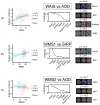Association of Neuroimaging Data with Behavioral Variables: A Class of Multivariate Methods and Their Comparison Using Multi-Task FMRI Data
- PMID: 35161969
- PMCID: PMC8839458
- DOI: 10.3390/s22031224
Association of Neuroimaging Data with Behavioral Variables: A Class of Multivariate Methods and Their Comparison Using Multi-Task FMRI Data
Abstract
It is becoming increasingly common to collect multiple related neuroimaging datasets either from different modalities or from different tasks and conditions. In addition, we have non-imaging data such as cognitive or behavioral variables, and it is through the association of these two sets of data-neuroimaging and non-neuroimaging-that we can understand and explain the evolution of neural and cognitive processes, and predict outcomes for intervention and treatment. Multiple methods for the joint analysis or fusion of multiple neuroimaging datasets or modalities exist; however, methods for the joint analysis of imaging and non-imaging data are still in their infancy. Current approaches for identifying brain networks related to cognitive assessments are still largely based on simple one-to-one correlation analyses and do not use the cross information available across multiple datasets. This work proposes two approaches based on independent vector analysis (IVA) to jointly analyze the imaging datasets and behavioral variables such that multivariate relationships across imaging data and behavioral features can be identified. The simulation results show that our proposed methods provide better accuracy in identifying associations across imaging and behavioral components than current approaches. With functional magnetic resonance imaging (fMRI) task data collected from 138 healthy controls and 109 patients with schizophrenia, results reveal that the central executive network (CEN) estimated in multiple datasets shows a strong correlation with the behavioral variable that measures working memory, a result that is not identified by traditional approaches. Most of the identified fMRI maps also show significant differences in activations across healthy controls and patients potentially providing a useful signature of mental disorders.
Keywords: ICA; IVA; data fusion; fMRI; neuroimaging; neuropsychology.
Conflict of interest statement
The authors declare no conflict of interest.
Figures










Similar articles
-
Disjoint subspaces for common and distinct component analysis: Application to the fusion of multi-task FMRI data.J Neurosci Methods. 2021 Jul 1;358:109214. doi: 10.1016/j.jneumeth.2021.109214. Epub 2021 May 3. J Neurosci Methods. 2021. PMID: 33957159 Free PMC article.
-
A CCA+ICA based model for multi-task brain imaging data fusion and its application to schizophrenia.Neuroimage. 2010 May 15;51(1):123-34. doi: 10.1016/j.neuroimage.2010.01.069. Epub 2010 Jan 28. Neuroimage. 2010. PMID: 20114081 Free PMC article.
-
Identification of Subgroup Differences Using IVA: Application to fMRI Data Fusion.Annu Int Conf IEEE Eng Med Biol Soc. 2020 Jul;2020:1683-1686. doi: 10.1109/EMBC44109.2020.9175837. Annu Int Conf IEEE Eng Med Biol Soc. 2020. PMID: 33018320
-
A survey on applications and analysis methods of functional magnetic resonance imaging for Alzheimer's disease.J Neurosci Methods. 2019 Apr 1;317:121-140. doi: 10.1016/j.jneumeth.2018.12.012. Epub 2018 Dec 26. J Neurosci Methods. 2019. PMID: 30593787 Review.
-
Shared and distinct brain fMRI response during performance of working memory tasks in adult patients with schizophrenia and major depressive disorder.Hum Brain Mapp. 2021 Nov;42(16):5458-5476. doi: 10.1002/hbm.25618. Epub 2021 Aug 25. Hum Brain Mapp. 2021. PMID: 34431584 Free PMC article. Review.
Cited by
-
Modern views of machine learning for precision psychiatry.Patterns (N Y). 2022 Nov 11;3(11):100602. doi: 10.1016/j.patter.2022.100602. eCollection 2022 Nov 11. Patterns (N Y). 2022. PMID: 36419447 Free PMC article. Review.
-
Functional magnetic resonance imaging study of group independent components underpinning item responses to paranoid-depressive scale.World J Clin Cases. 2023 Dec 26;11(36):8458-8474. doi: 10.12998/wjcc.v11.i36.8458. World J Clin Cases. 2023. PMID: 38188204 Free PMC article.
References
-
- Vidal-Ribas P., Janiri D., Doucet G.E., Pornpattananangkul N., Nielson D.M., Frangou S., Stringaris A. Multimodal neuroimaging of suicidal thoughts and behaviors in a US population-based sample of school-age children. Am. J. Psychiatry. 2021;178:321–332. doi: 10.1176/appi.ajp.2020.20020120. - DOI - PMC - PubMed
MeSH terms
Grants and funding
LinkOut - more resources
Full Text Sources
Medical
Miscellaneous

